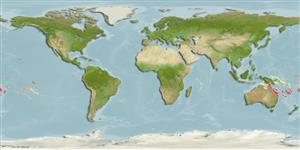Common names from other countries
Environment: milieu / climate zone / depth range / distribution range
Écologie
marin; saumâtre récifal; profondeur 2 - 30 m (Ref. 89972). Tropical; 0°N - 30°S
Pacific Ocean: Australia to Pitcairn.
Taille / Poids / Âge
Maturity: Lm ? range ? - ? cm
Max length : 20.0 cm TL mâle / non sexé; (Ref. 9710)
Épines dorsales (Total): 12 - 13; Rayons mous dorsaux (Total): 24-27; Épines anales 3; Rayons mous anaux: 20 - 21. Overall color is blackish with broad rim of yellow on dorsal caudal and anal fins. The snout is yellow with white tips. A black bump is on the forehead.
Found in coral rich to algae-covered rocky areas of lagoon and seaward reefs including estuarine areas. Usually paired (Ref. 9710). Omnivorous and feeds on algae, coral, and small benthic invertebrates. Oviparous (Ref. 205). Form pairs during breeding (Ref. 205). Maintaining this species in captivity is difficult.
Life cycle and mating behavior
Maturité | Reproduction | Frai | Œufs | Fécondité | Larves
Form pairs during breeding (Ref. 205). Monogamous mating is observed as both obligate and social (Ref. 52884).
Steene, R.C., 1978. Butterfly and angelfishes of the world. A.H. & A.W. Reed Pty Ltd., Australia. vol. 1. 144 p. (Ref. 4859)
Statut dans la liste rouge de l'IUCN (Ref. 130435)
CITES (Ref. 128078)
Not Evaluated
Utilisations par l'homme
Aquarium: Commercial
Plus d'informations
RéférencesAquacultureProfil d'aquacultureSouchesGénétiqueElectrophoresesHéritabilitéPathologiesTraitementMass conversion
Outils
Articles particuliers
Télécharger en XML
Sources Internet
Estimates based on models
Preferred temperature (Ref.
115969): 23.9 - 28.1, mean 26.4 (based on 448 cells).
Phylogenetic diversity index (Ref.
82804): PD
50 = 0.5000 [Uniqueness, from 0.5 = low to 2.0 = high].
Bayesian length-weight: a=0.02455 (0.01583 - 0.03806), b=3.05 (2.92 - 3.18), in cm Total Length, based on LWR estimates for this species & Genus-body shape (Ref.
93245).
Niveau trophique (Ref.
69278): 3.0 ±0.41 se; based on food items.
Résilience (Ref.
120179): Haut, temps minimum de doublement de population inférieur à 15 mois (Preliminary K or Fecundity.).
Fishing Vulnerability (Ref.
59153): Low vulnerability (10 of 100).
